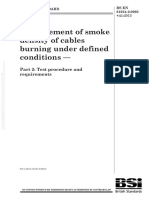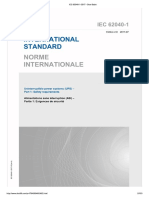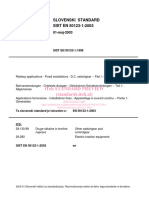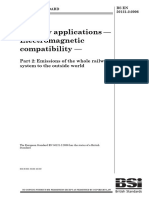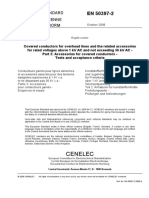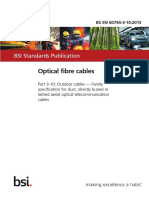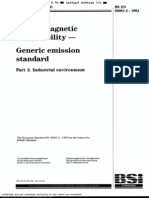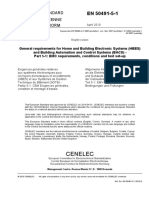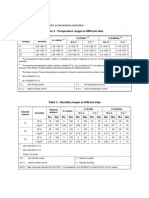Cenelec: European Standard Norme Europeenne Europäische Norm
Cenelec: European Standard Norme Europeenne Europäische Norm
Uploaded by
allan LCopyright:
Available Formats
Cenelec: European Standard Norme Europeenne Europäische Norm
Cenelec: European Standard Norme Europeenne Europäische Norm
Uploaded by
allan LOriginal Title
Copyright
Available Formats
Share this document
Did you find this document useful?
Is this content inappropriate?
Copyright:
Available Formats
Cenelec: European Standard Norme Europeenne Europäische Norm
Cenelec: European Standard Norme Europeenne Europäische Norm
Uploaded by
allan LCopyright:
Available Formats
EUROPEAN STANDARD EN 50124-1/A1
NORME EUROPEENNE
EUROPÄISCHE NORM October 2003
ICS 29.080.00; 45.020
English version
Railway applications -
Insulation coordination
Part 1: Basic requirements -
Clearances and creepage distances
for all electrical and electronic equipment
Applications ferroviaires - Bahnanwendungen -
Coordination de I'isolement Isolationskoord ination
Partie 1: Prescriptions fondamentales - Teil 1: Grundlegende Anforderungen -
Distances d'isolement dans I'air et Luft- und Kriechstrecken für alle
lignes de fuite pour tout materiel elektrischen und elektronischen
electrique et electronique Betriebsmittel
This amendment A 1 modifies the European Standard EN 50124-1 :2001; it was approved by CENELEC
on 2003-10-01. CENELEC members are bound to comply with the CEN/CENELEC Interna I Regulations
which stipulate the conditions for giving this amendment the status of a national standard without any
alteration.
Up-to-date lists and bibliographical references concerning such national standards may be obtained on
application to the Central Secretariat or to any CENELEC member.
This amendment exists in three official versions (English, French, German). A version in any other language
made by translation under the responsibility of a CENELEC member into its own language and notified to the
Central Secretariat has the same status as the official versions.
CENELEC members are the national electrotechnical committees of Austria, Belgium, Czech Republic,
Denmark, Finland, France, Germany, Greece, Hungary, Iceland, Ireland, Italy, Lithuania, Luxembourg, Malta,
Netherlands, Norway, Portugal, Slovakia, Spain, Sweden, Switzerland and United Kingdom.
CENELEC
European Committee for Electrotechnical Standardization
Comite Europeen de Normalisation Electrotechnique
Europäisches Komitee für Elektrotechnische Normung
Central Secretariat: rue de Stassart 35, B 1050 Brussels -
@ 2003 CENELEC - All rights of exploitation in any form and by any means reserved worldwide for CENELEC members.
Ref. No.EN50124-1:2001/A1:2003E
Uncontrolled copy when printed
EN 50124-1:2001/A1:2003 -2-
Foreword
This amendment to the European Standard EN 50124-1 :2001 was prepared by the Technical
Committee CENELEC TC 9X, Electrical and electronic applications for railways.
The text of the draft was submitted to the formal vote and was approved by CENELEC as
amendmentA1 to EN 50124-1:2001 on 2003-10-01.
The following dates were fixed:
- latest date by which the amendment has to be implemented
at national level by publication of an identical
national standard or by endorsement (dop) 2004-10-01
- latest date by which the national standards conflicting
with the amendment have to be withdrawn (dow) 2006-10-01
Annexes designated "normative" are part of the body of the standard.
Annexes designated "informative" are given for information only.
In this standard, Annexes A, ß, C and D are normative and Annexes E, Fand G are informative.
Annex F (informative) Bibliography
Add the following documents:
EN 50123 series Railway applications - Fixed installations - D.C. switchgear
EN 50152 series Railway applications - Fixed installations - Particular requirements for a.c.
switchgear
EN 50153 Railway applications - Rolling stock - Protective provisions relating to
electrical hazards
EN 61558 series Safety of power transformers, power supply units and similar devices
Uncontrolled copy when printed
-3- EN 50124-1 :2001/A1 :2003
Add the following annex:
Annex G
(informative)
Application guide
G.1 Introduction
The term "insulation co-ordination" explains the process for co-ordinating the constituents of an
electrical insulation, Le. solid/liquid insulation, clearances and creepage distances.
NOTE The dimensioning of insulation thicknesses perfonned by solid insulation and insulation distances perfonned by liquid insulation
materials is not covered by this standard.
However, the use of this standard for the determination of clearances and creepages needs some
additional explanations: The values of the tables of Annex Aare based on EN 60664-1 and
EN 60071-1 taking into account the severe electrical and mechanical situation of insulations in
railway systems and their expected reliability and long life time.
For example, the values for clearances are selected for inhomogeneous fields and, for locations
with typical railway pollutions are supplemented by safety margins. Thus, it is not necessary to
perform a high voltage test, when clearances required by this standard are achieved.
Where product standards for railway applications specify test voltages and clearances, the use of
these values is recommended. According to 1.1 it can be assumed that the insulation values in the
product standards were derived in accordance with this European Standard.
G.2 Determination of minimum clearances and creepage distances
G.2.1 Sections
For practical use when determining insulation values it is necessary to consider the following
factors when dividing into sections:
is the considered part of the circuit exposed to the same electrical climate? (working voltage,
overvoltage category);
are the location criteria of the regarded part of circuit the same? (pollution degree,
indoors/outdoors );
for economical reasons it may be useful to subdivide sections (e.g. for lower insulation values
in areas with lower voltage stress);
for reliability or safety reasons it may be useful to increase insulation values in endangered
areas, Le. by introducingaseparate section.
For floating sections consideration should be given to capacitive effects for defining the
dimensioning parameters of an insulation. Due to the actual or parasitic capacitances between the
regarded section and adjacent sections, creepage and clearances can be stressed by continuous
voltages greater than the nominal voltage of the circuit. The correct selection of 4Jm and 4Ji should
take that effect into account.
Uncontrolled copy when printed
EN 50124-1:2001/A1:2003 -4-
G.2.2 Use of method 1 and 2 for determining "'i
Methods 1 and 2 are considered as equivalent for dimensioning clearances because both methods
lead to reliable distances.
Method 2 is a physical method to determine an insulation value taking into account the voltage
stress occurring across the regarded insulation but it can only be used if the expected overvoltages
are weil known.
If the overvoltages are not known, method 1 should be used.
G.2.3 How to determine minimum clearances and creepage distances
The flowchart of Figure G.1 displays the procedure for determining the minimum clearances and
creepage distances by taking into account the relevant electrical, environmental and operating
conditions.
Uncontrolled copy when printed
-5- EN 50124-1:2001/A1:2003
EJ Division of the electrical circuit into
sections which are to be handled separately.
For all points of this section
3
the same voltage stress applies Sections 1,2,3......
The complete circuit or only a single point
of the circuit may be defined as a section For each section
the following steps are to be
performed
EJ Determination of rated insulation voltage
for the section of the circuit
tf..m
The section is powered direct by a
standardised railway volta ge {.f,
Rolling stock:
Manufacturer's determination
Table 0.1 according to 1.3.2.4 and Table A.1
Rated insulation voltage
for the section of the circuit
~m
EJ
ep 3
I
Selection of insulation type
According to 1.3.4 for the section
Product standards may state a preselectio
The section includes live parts.
The insulation provides a basic protection
against electric shock
Insulation between conductive parts In case of insulation failure,
only for properfunctioning the danger of an electric shock is given
Functional Basic
insulation insulation
Reinforced insulation
Double insulation
(as a single insulation
Basic + Suppl.
system)
EJ Choice of pollution degree
for the section of the circuit
Table A.4 + Annex E
Signalling
6.1
Pollution degree
PD1...PD4A
Pollution degree
Rolling stock PD1...PD4
6.2
Pollution degree
Fixed installation PD1...PD4B
6.3
Figure G.1 - Detennination of minimum clearances and creepage distances
Uncontrolled copy when printed
EN 50124-1 :2001/A 1 :2003 -6-
EJ Determination 01 rated Impulse voltage
for this section 01circuit
Uii
All overvoltages
are known by calculation
or by measurement
and the minimum clearance In air
Method 1 Method 2 (2.2.2.2)
According to 2.2.2.1 Calculation or measurement
01 this standard 01working peak voltages
Determination 01
Overvoltage categorie Calculation or measurement 01
OV1..0V4 all wolking peak voltages
2.2.2.1 in this section (including transient
and Clause 6 and induced voltages)
The maximum 01this peak
voltages is
lMm trom Step 2
PD trom Step 4
Table A3
Interpolation permitted
Minimum clearance lor basic insulation
Minimum clearance distances designed or measured
lor functional Insulation smaller values are not allowed
smaller values are allowed
but voltage test obligatory
according to
Clause 5 and Table A.8 Minimumclearance lor reinforced insulation according to 1,6 x Uii
distances designed or measured
smaller values are not allowed
u minimum
Determination
creepage
01
distance
lor the section 01 the circuit
Choice ofthe material group I, 11,lila, or IIIb
according to 2.6 and 4.1
&Nmlrom Step 2
Table A5. A6 or A.7
PD Irom Step 4 interpolation permitted
Minimum creepage diSfince
Minimum creepage distance lor basic insulation
lor functional insulation; smaller values are not allowed
values are lor basic insulation distances designed or measured according to Annex C
smaller values are not allowed Minimum creepage. minimum clearance
distances designed or measured
according to Annex C
Minimum creepage. minimum
clearance Minimum creepage distance
lor reinforced Insulation according to 2x~m
smaller values are not allowed
distances designed or measured according to Annex C
Minimum creepage. minimum clearance
Figure G.1 - Detennination of minimum clearances and creepage distances (concluded)
Uncontrolled copy when printed
-7- EN 50124-1 :2001/A 1:2003
G.2.4 Pollution
Table A.4 and Annex E may be used to identify the pollution degree applicable. Adefinition of a
pollution degree with numerical values is not practicable.
There is no direct relation between the protection level given by IP elasses of EN 60529 and the
pollution to be expected. The IP elasses are related to the protection against the ingress of solid
objects ineluding dust and against the ingress of water (e. g. spraying, splashing, water jets,
immersion, etc.). Protection according to IP classes cannot prevent pollution created by the
equipment itself.
The pollution degree PD1 may be used in areas of fixed installations and of signalling equipment
where the temperature and the humidity are permanently controlled. These conditions are normally
not given in rolling stock.
Table A.3 shows that for indoor locations (PD1 to PD3A) the pollution has no additional influence
on clearances above 1,6 mm. On the contrary, for PD4 in rolling stock outdoor installations and for
PD4A and PD4B in fixed installations, the pollution has a significant influence on clearances
throughout the whole voltage range. Therefore these clearances are derived from the size of solid
partieIes and the accumulation of pollutants likely to reduce the clearances.
For outdoor fixed installations special conditions (PD4A and PD4B) apply. It is because the
pollution at any particular area is always present for that particular area and may be very severe.
Rolling stock may operate in areas where the levels will be different and then the average level of
pollution and time of application should be considered. Also fixed installations may be cleaned less
frequently.
For further guidance in selecting PD4A and PD4B the following, which is based on IEC 60815,
should be noted:
PD4A "heavy conditions"
Areas with high density of industries and suburbs of large cities with high density of heating
plants producing pollution;
Areas elose to the sea or in any area exposed to relatively strong winds from the sea.
PD4B "very heavy conditions"
Areas generally of moderate extent, subjected to conductive dusts and to industrial smoke
producing particular thick conductive deposits;
Areas generally of moderate extent, very elose to the coast and exposed to sea spray or to
very strong and polluting winds from the sea;
Desert areas, characterised by no rain for long periods, exposed to strong winds carrying sand
and salt, and subjected to regular condensation.
Uncontrolled copy when printed
EN 50124-1:2001/A1:2003 -8-
G.2.5 Creepages
For creepages, the required distances increase with voltage for all pollution degrees. Values are
given in Tables A.5, A.6 and A.7 based on the rated insulationvoltage 4Jm.
Creepage distances cannot be validated by voltage tests because, among other reasons, the
influence of pollution cannot be simulated. Product standards will address for tests taking into
account pollution, if existing. Reduction of creepage distances is not allowed for either functional or
basic insulation.
G.2.6 Insulations
G.2.6.1 Types of insulation
Figure G.2 gives an example of types of insulation.
i functional ~ surfaceof metallic
solid
]'ation ! insulation
~enclosu,"
l--71 ~
c./ I~
insulation' InsulatJon I
I + 1Jthe creepage distance
: creepagerl
reinforced ~ = I
is regarded as
supplementary insulation
insulation I double I
i. insulation - -II
L ~
Figure G.2 - Example for types of insulation
G.2.6.2 Supplementary insulation
A supplementary insulation (see definition 1.3.4.3) is an additional independent insulation which is
intended to protect users from electric shock in the case of breakdown of basic insulation. The
electric stress of supplementary insulation in case of a failure can be different from the stress of
basic insulation under normal operating conditions.
NOTE 1 Supplementary insulation may be performed as a layer of solid insulation.
NOTE 2 Partial discharge may occur in the case of a combination of insufficient clearance and well-dimensioned solid insulation.
Sometimes additional insulation is provided in addition to basic insulation for mechanical protection
only, not to protect against electric shock. This additional insulation is not supplementary insulation
in the sense of 1.3.4.3, e.g. in the case of the outer sheath of a cable.
Supplementary insulation can be used for increasing the reliability of an insulation.
Uncontrolled copy when printed
-9- EN 50124-1:2001/A1:2003
G.2.6.3 Double insulation
An insulation system where a layer of a basic insulation is combined with a layer of a
supplementary insulation is called "double insulation". However, the combination of two functional
insulations is not a double insulation.
NOTE In braking resistors, the combination of a basic insulation with a functional insulation is sometimes termed "double insulation" but
does not fulfil the requirements as defined in this standard.
G.2.6.4 Reinforced insulation
A reinforced insulation is equivalent to a double insulation, when it is not possible to identify the
layers of basic and supplementary.
NOTE A typical example of the use of reinforced insulation is for safety transformers in accordance with the series EN 61558.
G.2.7 Use of minimum distances for clearances and creepage distances
These distances are values wh ich experience has found to be satisfactory in normal railway
operation with a good reliability of equipment.
All clearance and creepage distances dimensioned according to this standard are minimum
distances. The designer of an equipment is free to use larger distances.
NOTE Minimum values of clearances and creepage distances may be increased by the designer for specific requirements and service
conditions in order to increase reliability.
G.2.8 Roof equipment for rolling stock
The roof of a vehicle is considered as a "closed electrical operating area" in accordance with
EN 50153. In this special case, the insulation of the roof equipment may be considered as
functional insulation. If agreed between purchaser and supplier, the clearances may be reduced
accordingly.
It is recommended, however, to use higher values for creepages on the roof due to the level of
pollution likely to be expected in that area.
G.2.9 Special cases of switching arrangements in fixed installations
(see Table A.2, footnote 3)
Table A.2 gives values for ~i for the rated insulation voltage 52 kVa.c.
Switchgear intended to fulfil those requirements are used for example in substations where they
are connected to two phases of a three-phase network with a nominal voltage exceeding 25 kV. In
such cases the switching device shall be dimensioned for a higher voltage. The next standardised
value is then 52 kV in accordance with EN 60071-1.
In all other cases the relevant value of ~m is either 27,5 kV or 36 kV for a {In of 25 kV.
G.2.10 Insulation conditions in fixed installations (see 6.3.1.1)
Switching devices intended to isolate discrete sections of the contact line from the power source
are provided with an increased value for the rated impulse voltage ~i (up to 25 %).
Detailed values for rated impulse voltages across isolating distances of switching devices are
specified in the relevant product standards; for d.c. switching devices in the series EN 50123, for
a.c. switching devices in the series EN 50152.
Uncontrolled copy when printed
EN 50124-1:2001/A1:2003 -10-
G.3 Examples
Figure G.3 gives an example for sections. The diagram shows a monitoring circuit for the supply
voltage of a locomotive.
P1
:..~.=~ ~~r~ Soctioo 1 I
r ~_..O:I
~ .
..
I Section 2 Hm pi - -{111r- Roof
12.' Section 3 I
- ;;~!C ::.::.-~
-
GAP
2,5~F
to dc contral
device
-=
Figure G.3 - Monitoring circuit showing examples of sections
Figure GA shows a drawing of a monitoring device used as an example for determining clearance
and creepage distances related to the monitoring circuit of Figure G.3.
Uncontrolled copy when printed
-11 - EN 50124-1:2001/A1:2003
mineral oil +
silica
ceramic insulator
1-~1lJ
--,~r
TF1
Roof
Cap
\ Metallic box
Figure G.4 - Drawing of monitoring device
Device located on the locomotive roof supplied at two supply voltages:
.. 25 kVa.c.
.. 1,5kVd.c.
Determination of minimum clearances and creepage distances of the stepdown transformer TF1.
Step1 Seetion 1 Section 2 Seetion 3
(see diagram)
Step 2 Directly connected to the contact Not directlyconnectedto the Not directly connectedto the
line contact line contact line
Calculationwith primary voltage Calculationwith primary voltage
1,5 kV d.c. 25 kVa.c.
lf..m= 27,5 kV lf..m= 1,74 kV lf..m= 0,11 kV
Step 3 Basic insulation Functionalinsulation Functionalinsulation
Step 4 Pollution degree PD4 Pollutiondegree PD2 Pollutiondegree PD2
Step 5 Method 1 Method 1 Method 1
TableÄ.2- OV4 (no surgediverter) Table Ä.2 - OV2 Table Ä.1 - OV3
lf..1 = 170 kV lf..J= 10kV lf..1= 2,5kV
Table Ä.3 Table Ä.3 Table A.3
Minimum clearance =310 mm Minimum clearance =11 mm Minimumclearance = 1,5 mm
Step 6 Material group I Material group 11 Material group 111
Table A.7. 25 mm/kV Table Ä.7. 7,1 mm/kV Table Ä.6 - 0Nm= 125 V - PD2
Minimum creepage distance = Minimum creepage distance = Minimum creepage distance =
687 mm 12,4 mm 1,5mm
Figure G.5 - Example for the determination of clearances and creepage distances
Uncontrolled copy when printed
EN 50124-1:2001/A1:2003 -12-
G.4 Tests
G.4.1 Measuring
To demonstrate the compliance of the equipment with the insulation requirements, it is necessary
to measure the clearance and creepage distances.
In order to limit the amount of measurements, it is recommended to identify where the minimum
clearances and creepage distances occur. If measurement is difficult on the complete item, it is
recommended to do this on a relevant subassembly.
If the measurement of clearances is not possible, a voltage test is performed in accordance with
5.3, 5.4 or 5.5 on a subassembly to avoid overstressing of the equipment.
If the clearances for functional insulation are smaller than those specified in Table A.3, a voltage
test is mandatory.
For measuring of creepage distances refer to Annex C.
G.4.2 Testing
Two kinds of voltage tests are given in this standard:
a) Tests for verification of clearances (see Clause 5 and Table A.B)
This test is a type test. Where a relevant product standard specifies requirements for such a
test, the test should be performed in accordance with the product standard. In all other cases
Clause 5 applies.
In the case of functional insulation when the clearance has been reduced, the voltage test is
carried out at the value for the unreduced cIearance. When carrying out the test to verify
clearances, it is good practice to test only the parts under consideration. It is acceptable to use
a representative subassembly.
b) Dielectric test voltages for equipment (see Annex B, Table B.1)
This routine test is only valid for items of equipment when there is no relevant product
standard.
The test voltages for dielectric testing are based on the rated impulse voltage 4Ji taking into
account the overvoltage categories. Test voltages in most product standards, however, are
conventionally based on the nominal voltage or the rated insulation voltage of the equipment.
The test voltages of Table B.1 are not used for checking clearances.
Uncontrolled copy when printed
You might also like
- X bILL xFINITYDocument6 pagesX bILL xFINITYBryan67% (6)
- BS en 50129Document98 pagesBS en 50129Nelson Cheung83% (6)
- BS EN 50131-1-2006+a1-2009iDocument42 pagesBS EN 50131-1-2006+a1-2009iciscobox67% (3)
- En Iec 61000-6-2-2019Document21 pagesEn Iec 61000-6-2-2019Muhammed Hasan Güçlü100% (1)
- EN-50121-1-2017-Railway applications-EMC-Part 1-GeneralDocument13 pagesEN-50121-1-2017-Railway applications-EMC-Part 1-GeneralsanjaigNo ratings yet
- BS en 62386-101-2014Document84 pagesBS en 62386-101-2014macare9784No ratings yet
- Hunter The Reckoning - 2 Page Character SheetDocument2 pagesHunter The Reckoning - 2 Page Character SheetConsignmenttoduat0% (1)
- Remote Control Codes For Telefunken TVs - Codes For Universal RemotesDocument20 pagesRemote Control Codes For Telefunken TVs - Codes For Universal RemotesEbenNo ratings yet
- BS EN 61643 31 2019 Low Voltage Surge Protective Devices Part 31 Requirements and Test Methods For SPDs For Photovoltaic Installations PDFDocument64 pagesBS EN 61643 31 2019 Low Voltage Surge Protective Devices Part 31 Requirements and Test Methods For SPDs For Photovoltaic Installations PDFChang LeeNo ratings yet
- Introduction to Power System ProtectionFrom EverandIntroduction to Power System ProtectionRating: 4 out of 5 stars4/5 (2)
- European Standard Norme Européenne Europäische Norm: Railway Applications Electromagnetic Compatibility Part 1: GeneralDocument14 pagesEuropean Standard Norme Européenne Europäische Norm: Railway Applications Electromagnetic Compatibility Part 1: GeneralsebastiannistorNo ratings yet
- Iec 61034-2Document22 pagesIec 61034-2sohaib100% (2)
- BS en 50123-7-2-2003Document12 pagesBS en 50123-7-2-2003Sikandar MirzaNo ratings yet
- En 50085-1Document15 pagesEn 50085-1Mahmoud ShaheenNo ratings yet
- BS EN 50483-2-2009 EnglishDocument29 pagesBS EN 50483-2-2009 EnglishДмитро Денис0% (1)
- IEC 62040-1 Safety Requirements PDFDocument151 pagesIEC 62040-1 Safety Requirements PDFallan L0% (3)
- Power SystemDocument26 pagesPower Systemanandvmahadik50% (2)
- Sist en 50123 1 2003Document13 pagesSist en 50123 1 2003eng.ahmedhassan200No ratings yet
- BS en 50363-2-1-2005+a1-2011 - (2023-06-01 - 10-22-38 Am)Document12 pagesBS en 50363-2-1-2005+a1-2011 - (2023-06-01 - 10-22-38 Am)Michele Vannella100% (1)
- Une-En 50122-1Document84 pagesUne-En 50122-1María Hidalgo Murillo100% (3)
- En50288-1 2003Document16 pagesEn50288-1 2003namheeNo ratings yet
- Railway Applications - Fixed Installations - Electrical Safety, Earthing and The Return CircuitDocument34 pagesRailway Applications - Fixed Installations - Electrical Safety, Earthing and The Return CircuitCounter RoverNo ratings yet
- LVD Ed StandardsDocument91 pagesLVD Ed StandardsShekharChambyalNo ratings yet
- BS EN 60811-1-1 1995 FileDocument28 pagesBS EN 60811-1-1 1995 Fileelmaadawy2002100% (3)
- Cenelec: European Standard Norme Européenne Europäische NormDocument21 pagesCenelec: European Standard Norme Européenne Europäische NormRamil ValenzuelaNo ratings yet
- Cenelec: European Standard Norme Européenne Europäische NormDocument1 pageCenelec: European Standard Norme Européenne Europäische Normjunaraso53No ratings yet
- Bds en 50122 1 2011 Railway Applications Fixed InstallationsDocument92 pagesBds en 50122 1 2011 Railway Applications Fixed Installationsfild225No ratings yet
- EN-62561-1 2011 AA 2012 Vot1eDocument6 pagesEN-62561-1 2011 AA 2012 Vot1epemanr1914No ratings yet
- CELEX 52013XC1128 (06) en TXTDocument95 pagesCELEX 52013XC1128 (06) en TXTmoktar albhlolyNo ratings yet
- En 50081-2Document6 pagesEn 50081-2ludovica0_0No ratings yet
- Bs en 50121-2-2006 铁路设施.电磁兼容性.整个铁路系统对外界的辐射Document26 pagesBs en 50121-2-2006 铁路设施.电磁兼容性.整个铁路系统对外界的辐射Yung-chiangLeeNo ratings yet
- En 50397-2 PDFDocument43 pagesEn 50397-2 PDFJCuchapin100% (1)
- Communication Cables-Specification For Test MethodsDocument54 pagesCommunication Cables-Specification For Test MethodsquycoctuNo ratings yet
- BS en 50264-3-1-2008Document28 pagesBS en 50264-3-1-2008Shivangi BhardwajNo ratings yet
- Directive Low VoltageDocument137 pagesDirective Low Voltageximeres0% (1)
- LVD Harmonised Standards PDFDocument91 pagesLVD Harmonised Standards PDFShekharChambyalNo ratings yet
- Railway Applications - Fixed Installations - Electrical Safety, Earthing and The Return CircuitDocument34 pagesRailway Applications - Fixed Installations - Electrical Safety, Earthing and The Return CircuitCounter RoverNo ratings yet
- TS en 61672-1Document55 pagesTS en 61672-1Tit fuckerNo ratings yet
- Ds 0071 22 Emc NoticeDocument16 pagesDs 0071 22 Emc NoticePierre-Olivier MouthuyNo ratings yet
- BS en 60794-3-10-2015Document18 pagesBS en 60794-3-10-2015Amer AmeryNo ratings yet
- No.13 EN 60745-2-1Document8 pagesNo.13 EN 60745-2-1phucNo ratings yet
- Bsen 50081 2Document14 pagesBsen 50081 2Dumitru Cristina100% (1)
- EN 50483-2 自承重系统的耐张与悬垂线夹Document32 pagesEN 50483-2 自承重系统的耐张与悬垂线夹jqs190811No ratings yet
- Conduit Systems For Cable ManagementDocument20 pagesConduit Systems For Cable ManagementHong Son NguyenNo ratings yet
- EN 50341-3 (2001) Tpe (Linhas Aéreas Maior 45 KV)Document2 pagesEN 50341-3 (2001) Tpe (Linhas Aéreas Maior 45 KV)veraNo ratings yet
- rEN 50121 X Railway EMC Standards P PDFDocument7 pagesrEN 50121 X Railway EMC Standards P PDFGoyal SanjaiNo ratings yet
- Bsen 61386-24-2010Document20 pagesBsen 61386-24-2010TIRUPATI PLASTOMATICS (LAB)No ratings yet
- EN 55035-2017 Electromagnetic Compatibility of Multimedia Equipment - Immunity RequirementsDocument90 pagesEN 55035-2017 Electromagnetic Compatibility of Multimedia Equipment - Immunity RequirementsRobert LegaultNo ratings yet
- Bsi BS en 60952-1 - 2013Document44 pagesBsi BS en 60952-1 - 2013alferedNo ratings yet
- BS en 50443 2011 Effects of ElectromagneticDocument32 pagesBS en 50443 2011 Effects of Electromagneticmehrnoosh fakhariNo ratings yet
- BS en 55035-2017Document90 pagesBS en 55035-2017flaviopoNo ratings yet
- Normas Eléctricas para VIADocument16 pagesNormas Eléctricas para VIAAntónio AlmeidaNo ratings yet
- Cenelec: European Standard Norme Européenne Europäische NormDocument17 pagesCenelec: European Standard Norme Européenne Europäische NormИрина ГорбенкоNo ratings yet
- Bs en 50182-2001 架空线导体 圆线共轴布线标准导体Document78 pagesBs en 50182-2001 架空线导体 圆线共轴布线标准导体Kassem Baalbaki100% (2)
- European Standard Norme Européenne Europäische Norm: Raised Access FloorsDocument34 pagesEuropean Standard Norme Européenne Europäische Norm: Raised Access FloorsCarla TraistaNo ratings yet
- En 61000-6-3 - 2007 PDFDocument20 pagesEn 61000-6-3 - 2007 PDFmadslayers100% (1)
- EN 50122-1-2022 SIST - Railway Applications - Fixed Installations - Part 1 Protective Provisions Against Electric ShockDocument15 pagesEN 50122-1-2022 SIST - Railway Applications - Fixed Installations - Part 1 Protective Provisions Against Electric ShockKereta KebalNo ratings yet
- En 50125 2 2002Document22 pagesEn 50125 2 2002BurtPersson100% (1)
- Guide to the IET Wiring Regulations: IET Wiring Regulations (BS 7671:2008 incorporating Amendment No 1:2011)From EverandGuide to the IET Wiring Regulations: IET Wiring Regulations (BS 7671:2008 incorporating Amendment No 1:2011)Rating: 4 out of 5 stars4/5 (2)
- It Is Quite Another Electricity: Transmitting by One Wire and Without GroundingFrom EverandIt Is Quite Another Electricity: Transmitting by One Wire and Without GroundingNo ratings yet
- Electromagnetic Compatibility (EMC) Design and Test Case AnalysisFrom EverandElectromagnetic Compatibility (EMC) Design and Test Case AnalysisNo ratings yet
- Guidelines for the Determination of Standardized Semiconductor Radiation Hardness ParametersFrom EverandGuidelines for the Determination of Standardized Semiconductor Radiation Hardness ParametersNo ratings yet
- Signal Integrity: From High-Speed to Radiofrequency ApplicationsFrom EverandSignal Integrity: From High-Speed to Radiofrequency ApplicationsNo ratings yet
- Protection of Substation Critical Equipment Against Intentional Electromagnetic ThreatsFrom EverandProtection of Substation Critical Equipment Against Intentional Electromagnetic ThreatsNo ratings yet
- Ieee 485 PDFDocument69 pagesIeee 485 PDFallan LNo ratings yet
- Betta Batteries From SiemensDocument31 pagesBetta Batteries From Siemensallan LNo ratings yet
- Signalling and Telecommunication AC Standards As Per EN 50125-3Document1 pageSignalling and Telecommunication AC Standards As Per EN 50125-3allan LNo ratings yet
- BTY79 SeriesDocument4 pagesBTY79 SeriesAmanda BentoNo ratings yet
- References STP Aviation EnglishDocument9 pagesReferences STP Aviation Englishexemplo55509No ratings yet
- Write The Description of Your Ideal Job Place. Use There Is and There Are Write Is or Are A, An, Any. Then Answer The Questions About This OfficeDocument6 pagesWrite The Description of Your Ideal Job Place. Use There Is and There Are Write Is or Are A, An, Any. Then Answer The Questions About This OfficeLeidy Lorena Ricon ReyNo ratings yet
- Group 16 ProjectDocument18 pagesGroup 16 ProjectOluwa MuyiwaNo ratings yet
- 04 Jet Mixing Design ApplicationsDocument6 pages04 Jet Mixing Design Applicationslutfi awn100% (1)
- 11 Economics Notes Ch13Document4 pages11 Economics Notes Ch13HackerzillaNo ratings yet
- CBM 121 Week 7 - 9Document21 pagesCBM 121 Week 7 - 9RONNIE JR FABELANo ratings yet
- Data Types1Document25 pagesData Types1iitiansrd2025No ratings yet
- Associative Projective NN 1991Document9 pagesAssociative Projective NN 1991Jacob EveristNo ratings yet
- Folleto LCCDocument74 pagesFolleto LCCGerman DiBaccoNo ratings yet
- Instrumentation and Controls AP1000 Design Control DocumentDocument6 pagesInstrumentation and Controls AP1000 Design Control DocumenthafizgNo ratings yet
- W80 Triplex Pump W375 Quintuplex PumpDocument2 pagesW80 Triplex Pump W375 Quintuplex Pumpadewunmi olufemiNo ratings yet
- 2023 Hit-List For Public AdministrationDocument7 pages2023 Hit-List For Public AdministrationmanalkimannuNo ratings yet
- Set-A: Date: 14/02/2023 at 11:59 AMDocument4 pagesSet-A: Date: 14/02/2023 at 11:59 AMعلي احمدNo ratings yet
- Biomedical Ktu EceDocument34 pagesBiomedical Ktu EceGreeshma RatheeshNo ratings yet
- FINA 5190 Course Outline - 2020 - King Peng - Final VersionDocument7 pagesFINA 5190 Course Outline - 2020 - King Peng - Final VersionTak Ming ChanNo ratings yet
- Engine Parts: Block BloqueDocument26 pagesEngine Parts: Block BloqueGrover YersonNo ratings yet
- Kinds of Sentences - Passive Voice - FlowchartDocument4 pagesKinds of Sentences - Passive Voice - FlowchartNguyễn Ngọc Bảo TrânNo ratings yet
- Flexi-Tank Installation and Use InstructionsDocument50 pagesFlexi-Tank Installation and Use Instructionsricm152No ratings yet
- Week 4 Ethical Decision Making ProcessDocument16 pagesWeek 4 Ethical Decision Making Processapi-3709645No ratings yet
- B Force On A Wire MC Questions PDFDocument6 pagesB Force On A Wire MC Questions PDFLynn Hollenbeck BreindelNo ratings yet
- Dulcet ManualDocument2 pagesDulcet ManualejdalcinNo ratings yet
- Clutch Problems 332Document3 pagesClutch Problems 332Nova April100% (2)
- Gendered Styles of FriendshipsDocument54 pagesGendered Styles of FriendshipsPhilanderGereenPiniliNo ratings yet
- What Are The Main Differences Between The Orientation Design School and Planning School Guidance On Formalizing The StrategyDocument3 pagesWhat Are The Main Differences Between The Orientation Design School and Planning School Guidance On Formalizing The StrategykarimaelNo ratings yet
- Avishkar Project 2021Document7 pagesAvishkar Project 2021Shahnawaz AnsariNo ratings yet











